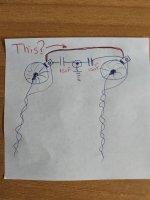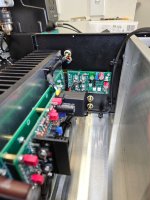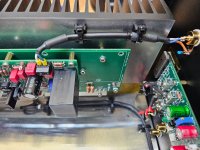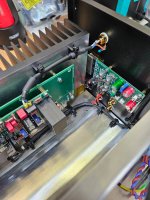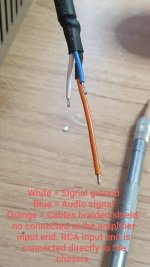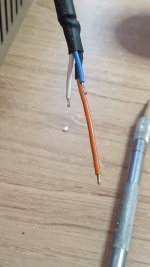Just reporting something I did, today ... just in case anyone else has noise-floor problems.
When I built my ANs, I was always conscious of some hiss from the tweeters and a buzz from the mid-bass drivers ... low-level and probably not hearable at the listening position - but annoying all the same.
But I recently read a 'white paper' on reducing noise in amplifiers; it covered all the normal things like twisting wires together - but I did come across an idea which I'd never thought about before.
This was, to ideally have the L&R input RCAs located close to each other, to "reduce the loop area", But, if not - to attach an earth wire from the RCA earth tag on the Left input ... to the RCA earth tag on the Right input.
Normally, I do have both input RCAs close to each other in a build - but in the AN's case, due to the board layout inside the case, I had the input RCAs on the outer edges of the back panel ... so as to keep them as far away from the mains wiring as possible.
Anyway, attaching an earth wire between the input RCA earth tags (and routing this earth wire well clear of the mains wiring) ... has resulted in an absolutely quiet amplifier! 👍
When I built my ANs, I was always conscious of some hiss from the tweeters and a buzz from the mid-bass drivers ... low-level and probably not hearable at the listening position - but annoying all the same.
But I recently read a 'white paper' on reducing noise in amplifiers; it covered all the normal things like twisting wires together - but I did come across an idea which I'd never thought about before.
This was, to ideally have the L&R input RCAs located close to each other, to "reduce the loop area", But, if not - to attach an earth wire from the RCA earth tag on the Left input ... to the RCA earth tag on the Right input.
Normally, I do have both input RCAs close to each other in a build - but in the AN's case, due to the board layout inside the case, I had the input RCAs on the outer edges of the back panel ... so as to keep them as far away from the mains wiring as possible.
Anyway, attaching an earth wire between the input RCA earth tags (and routing this earth wire well clear of the mains wiring) ... has resulted in an absolutely quiet amplifier! 👍
@andyr
Thanks for your confirmations Andy! It agrees with the recommendations brought forth by Andrew Russell @Bonsai of Hifisonix if I am reading it correctly:
https://www.hifisonix.com/articles/reducing-loop-area-in-audio-power-amplifier-wiring/
Best,
Anand.
Thanks for your confirmations Andy! It agrees with the recommendations brought forth by Andrew Russell @Bonsai of Hifisonix if I am reading it correctly:
https://www.hifisonix.com/articles/reducing-loop-area-in-audio-power-amplifier-wiring/
Best,
Anand.
@andyr
Thanks for your confirmations Andy! It agrees with the recommendations brought forth by Andrew Russell @Bonsai of Hifisonix if I am reading it correctly:
https://www.hifisonix.com/articles/reducing-loop-area-in-audio-power-amplifier-wiring/
Best,
Anand.
It was a different white paper that I read, Anand ... but it had similar diagrams - so maybe Andrew Russell had some input to the one I read. 👍
Another interesting point in the article - which I certainly have never tried - is to rotate your power transformer in a 60 deg arc; one position within this arc ... will produce the lowest noise from the spkrs! 😵
Andyr can you post a photo of the wiring ?Anyway, attaching an earth wire between the input RCA earth tags (and routing this earth wire well clear of the mains wiring) ... has resulted in an absolutely quiet amplifier! 👍
Andyr can you post a photo of the wiring ?
Yassou, Nikos.
PITA - but here ya go, mate:
Regards,
Andy
The correct connection from Wolverine Team.
Attachments
Did you do this? Because it's a little difficult for someone to distinguish the correct connection
Exactly - except I didn't include the 10nF caps.
And you did this due to the large distance between the two RCA.?
That's right! 👍
The correct connection from Wolverine Team.
Not sure what you mean re. "The correct connection", Nikos?
The Wolverine guys have done what they think should be done. I've simply done what I read about in a white paper ... because I had my L & R input RCAs a long way apart - and this has resulted in me now having dead-quiet ANs.
So I'm a very happy chappy! 🙂
You're right, it's a very general term and not individualized. But look at mine, I just put a double shielded cable, even though I didn't connect it to ground, the measured noise decreased by about 80%Not sure what you mean re. "The correct connection", Nikos
Getting close, waiting on the case...

Getting close, waiting on the case...
Looking great.
You have the RCA input sockets close together ... so I don't think you'll experience the noise problem that I used to have (before I connected the input earth tags together).
But can I suggest that, given your narrow, deep case - instead of placing the toroids as you've shown in the pic ... you mount them vertically, on 'L' brackets which are oriented at 90 deg to each other (to reduce interaction between them).
Also, enclose the toroids' primary wires in a woven metal shield (earthed to the case earth bolt), back to the IEC socket, in order to minimise mains pickup.
I've been doing some layout planning, also created a cleaned up wiring diagram. I think I'm going to go with a second level for the power supply for this build. I'll be taking my time with this part... slow but steady progress.



What was probably happening on your build was that you had a large loop area between the channels inside the amplifier chassis because the connectors were on opposite sides of the rear panel and that loop would have that was extended out to the source equipment. So the loop went from one input to the other input inside the amplifier via the amp module to the PSU and then to the other amp module, then out to the source equipment and then back again to the original input. Any cross-channel ground loop currents arising inside the amplifier (very easy for this to happen) flowed around this loop and through any signal return resistances, causing a voltage drop. This voltage drop is a noise signal and appears in series with the input. Typically, it sounds like an irritating buzz, as it is at 2x the mains frequency, plus a lot of harmonics due to the rectification process. By shorting the two input grounds together the way you have done, you have trapped the cross-channel ground loop inside the amplifier, so it is no longer flowing through the external interconnect screen resistances, and your amp is now quieter as a result.Just reporting something I did, today ... just in case anyone else has noise-floor problems.
When I built my ANs, I was always conscious of some hiss from the tweeters and a buzz from the mid-bass drivers ... low-level and probably not hearable at the listening position - but annoying all the same.
But I recently read a 'white paper' on reducing noise in amplifiers; it covered all the normal things like twisting wires together - but I did come across an idea which I'd never thought about before.
This was, to ideally have the L&R input RCAs located close to each other, to "reduce the loop area", But, if not - to attach an earth wire from the RCA earth tag on the Left input ... to the RCA earth tag on the Right input.
Normally, I do have both input RCAs close to each other in a build - but in the AN's case, due to the board layout inside the case, I had the input RCAs on the outer edges of the back panel ... so as to keep them as far away from the mains wiring as possible.
Anyway, attaching an earth wire between the input RCA earth tags (and routing this earth wire well clear of the mains wiring) ... has resulted in an absolutely quiet amplifier! 👍
For future builds, it is a good idea to keep the connectors together on the rear panel and bond the signal returns together right at the connector. Then wire a 10-50nF ceramic capacitor from the bonded signal returns to the chassis right where the connectors are. This effectively shields the chassis and interconnect cable from RF ingress because the cable screen and the amplifier chassis appear as a single housing to RF.
On the Wolverine, the internal braided shield, which is connected only on one side, provides additional RFI immunity to the cable interconnect between the input connector and the amp module. This can help protect against HF noise in the amplifier, which may arise from the rectification process, where the rectifiers can 'ring' at very high frequencies.
It's essential to note that a screened cable does not provide noise reduction from mains hum. A screened cable is used primarily to prevent RF ingress, provided the screen is correctly connected between the equipment. The best defence against mains hum/buzz is to reduce loop areas (screened cable can help here because the loop area is naturally small, but tightly twisted pair works just as well at audio) and then make sure you don't have cross channel ground loops or common impedance coupling, which can be especially problematic if the grounding is not ordered correctly on the amplifier modules, or at the power supply.
Last edited:
- Home
- Amplifiers
- Solid State
- Alpha Nirvana 39w 8ohm Class A Amp
